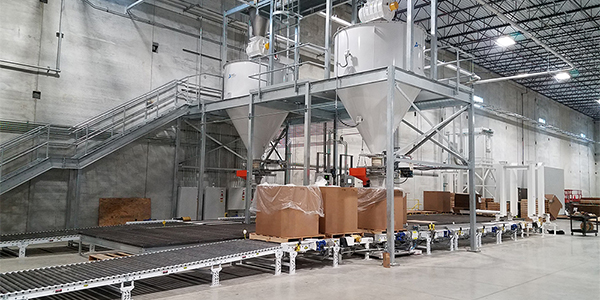

Pneumatic conveying systems, in theory, are simple. They convey product from point A to point B. However, in a chemical plant environment, there are several factors that demand careful consideration. Understanding your products and their characteristics will affect the design of a pneumatic conveying system. An appropriately designed system will provide a system that performs optimally, is robust, and lowers your costs.
How do you know a pneumatic system will be right for your chemical products and facility? Take the following 11 factors into consideration.
1. Pneumatic Conveying Suitability
Is your product conveyable? Depending on the product’s characteristics, some materials can be problematic to pneumatically convey. Take titanium dioxide, when conveyed, it tends to clump and smear. It can be difficult to discharge from hoppers and wants to stick to filters. Depending upon the customer’s process, a pneumatic convey system may be acceptable or alternative form of conveying may need to be considered.
2. Dilute or dense phase conveying
Dilute phase conveying suspends products in an airstream and moves them from point A to point B relatively quickly, running 0 to 14.7 psig. It uses ambient air, which of course is free. The velocity is high and the pressure needed to counteract friction is low, so there is less product contact with the pipe and the product remains suspended in the airstream. This is best for powders and products with powder-like qualities where degradation is not a concern.
Dense phase conveying moves product relatively slowly (0-150 psig), letting it slide through the pipe, often in slugs or waves. This requires lower velocities and higher pressures. A pressure dense phase system uses compressed air, which adds cost, and it is best for a homogenous blend or preventing product degradation. Dense phase oftentimes can be used to achieve higher transfer rates as well.
3. Pressure or vacuum conveying
Pressure systems are more efficient since they require less energy to transfer materials. Pressure systems are often selected due to the convey distance or when conveying from on source to multiple destinations. Vacuum systems still serve certain purposes though and can often present advantages over pressure systems in different situations. Vacuums are cleaner by nature, but also require more energy. Vacuum systems are often a good selection when conveying from multiple place to one final destination. Choosing boils down to your products’ characteristics, convey parameters, and personal preference.
4. Temperature control
Certain materials have lower melt points and/or can have their chemical composition be altered by temperature. Consideration must be given to temperature management as to provide the best conditions to convey your materials.
5. Moisture content
Is your product hygroscopic? When materials absorb excessive moisture, it can impact their ability to be pneumatically conveyed. Moist materials can smear convey lines, adhere to and blind filters, clump, and even turn to rocks, which causes difficulties in conveying and discharging of the hydroscopic material.
6. Product degradation
Is your product at risk of degradation? Both raw materials and finished products can be damaged if not pneumatically conveyed properly. Degradation oftentimes impacts the final product’s quality or characteristics. For example, degraded granular sugar may cause your lemonade to appear cloudy or your favorite cookie to spread out on the cookie sheet.
7. Reactivity
Does your product react with other materials? Understanding the reactivity will determine what construction materials need to be considered (i.e., aluminum, carbon steel, stainless steel, etc.) and if a dedicated system may be required due cross contamination issues.
8. Convey parameters
How far will your product be conveyed? Ten feet? 700 feet? There a several criteria needed to evaluate a suitable system design. Rate, distance, and timing all impact the system design. Pressure systems typically convey further with less energy, but vacuum systems are often selected due to a cleaner process. There are pros and cons of each type of pneumatic conveying.
9. Design of equipment
Your product characteristics are top of mind when designing pneumatic systems. For example, a vacuum transfer system may be beneficial for a product with a low melt point. Some products do not discharge well once in a hopper. As such, steeper sloped hoppers and flow aids may be used to aid in the discharging the product.
10. Conveyance with gases other than air
Nitrogen, an inert gas, when used to convey product can eliminate explosion hazards and act as a preservation agent. CO2 , also inert, can be used to chill or cool a product or blanket the product for protection.
11. Throughput
Does your formula involve multiple stages? Perhaps, two or three ingredients are added and mixed for a period before the next stage calls out adding more ingredients and mix time? A pneumatic system should be designed to mirror your production process. A comprehensive understanding of the formulation will allow your system to be designed properly from the beginning.
Attention Now Avoids Problems Down the Line
Attention to the design of pneumatic conveying systems in the chemical industry can help avoid problems, such as low conveying rates, high pressure/vacuum drops, plugging of the system, excessive wear-and-tear in the line, product degradation, and product cross contamination.
Conveying product, especially chemicals, is as much art as it is science. Our experts understand the complete process from beginning to end. How can we help? Contact us.